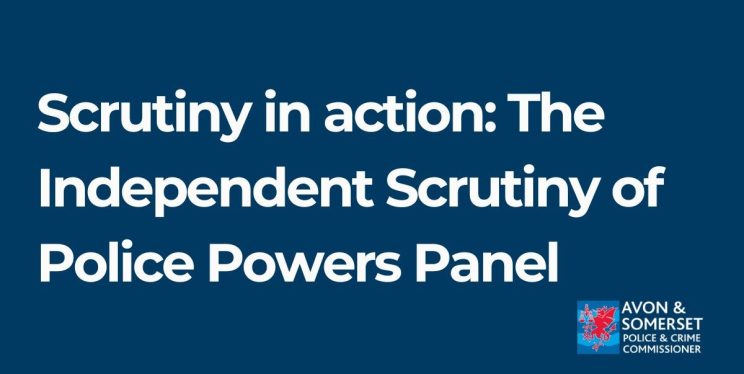Scrutiny in action: The Independent Scrutiny of Police Powers Panel

The Independent Scrutiny of Police Powers (ISOPP) panel comprises volunteers from diverse backgrounds in the local community who play a pivotal role in monitoring the use of force and stop and search powers by the police. This is one of a series of blog posts detailing the panel’s most recent session.
The ISOPP Panel meets quarterly to scrutinise files and footage related to the police’s exercise of their powers. The meeting is attended by the panel members, representatives from Avon and Somerset Police, and representatives from the Office of the Police and Crime Commissioner (OPCC). After each meeting, the panel produces a comprehensive report detailing their findings. This report is then submitted to the Police and Crime Commissioner for oversight, as well as to the police for a response.
After the usual start of teas, coffees, and introductions that all meetings everywhere begin with, this time the panel also starts with a sad but thoughtful moment of reflection for the panel’s chair, David Woodward, who had passed away that week.
Adeela Shafi, the panel’s Co-Vice Chair, asked people to share their memories of David, who was one of the first panel members from its start in 2015. Many fond memories were shared but the one that captures the essence of David’s approach and legacy was from Chief Inspector Vicks Hayward-Melen:
“From a policing point of view: If it’s possible to be tenaciously dignified that was David. It has led to changes for the people of Avon and Somerset. He had a respectful and calm ferocity which he applied, such as to his work on asking for personal details on stop and search. This new stop and search policy is just part of David’s legacy.”
After time spent sharing stories and considering how best to recognise David’s contributions, the panel moved onto the body of the session, scrutinising police use of powers.
Body Worn Camera Footage (BWC)
The panel members usually review the body worn footage of around 50 cases per quarter ahead of the meeting, feeding back good practice and areas for improvement. During the panel meeting, they select a 5-10 cases of note to discuss together as a panel and go through in more detail. These cases are chosen by the panel as examples of both best practice and to highlight any areas of concern.
The panel and representatives from Avon and Somerset Police and the Office of the Police and Crime Commissioner watch the selected videos of BWC footage on a large screen. After each video, the panel members ask questions and give feedback.
The videos and panel feedback: Video 1
The panel is shown BWV of an incident in which two officers attend a person’s home to provide a welfare check on someone who is threatening to harm himself. He has also said he may harm others. They arrested him and used force.
The video starts with the officers at the man’s door where they accidentally get some personal information about the man wrong and then attempt to force the man to keep his front door open by one of the officers putting his foot in the door. The man becomes distressed, he strikes one of the officers in the face. The situation escalates to the man on the floor being handcuffed and sprayed with PAVA which is similar to pepper spray.
ISOPP Panel questions and feedback
The first line of questioning raised by the panel was focused on the officers’ perceptions and experiences of fight or flight trauma reactions that the officers might have, both for themselves and for the person they are checking in on.
They point out the importance of correct information: “If you’re having a mental health episode and someone comes to your house and gets personal information wrong, it can make things worse.”
The panel picks up on the details in the video and combines it with knowledge of the police processes gained through training and experience of working with the police: “When he was handcuffed, he was on the floor for 18 minutes with no offer of water; usually when we see people have been PAVA sprayed there is more care given.”
The panel assessed the video, highlighting good practice and bad practice. One of the officers was unable to de-escalate the situation, one was trying to and was nearly able to. The police are able to answer questions about the level of risk in the situation, e.g., “we don’t know if there is anyone else in the house whose safety the officers needed to be aware of”.
The panel finds that organisational learning is needed specifically more training on mental health in this case.
Video 2
The panel is shown BWV of an incident in which someone has called the police to report an incident of racial abuse. Two officers are attending, they split up and talk to both people involved in the incident. The first man explains that another man has racially abused him and spat in his face. The other man claims the first man threatened him with a weapon. The police talk to both parties. Information is taken from both men and the man who was accused of having a weapon is searched.
ISOPP Panel questions and feedback
The panel highlights the ways the police officers kept the situation calm: the officers explained what they were doing as they were doing it. It was noted that they were kind and respectful to all concerned, which helped to keep the situation calm and contained.
Conclusion
The panel’s findings will be written into a report that will be shared with the police for learning. Some of the feedback will be shared with the officers involved, this can form part of line management discussions and in more serious cases may be used as part of a reflective practice session.
